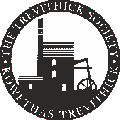Welcome
To the Trevithick Society
As a Registered Charitable Incorporated Organisation, number 1159639, the Society aims to encourage an interest in Cornwall’s Industrial Heritage through lectures, outings and other meetings and by publishing the results of individual research through its website, journal and other publications.
The Society encourages the sympathetic re-use of redundant industrial buildings along with the statutory protection and preservation of prime examples of all types. It sees recording as an important part of its work where the preservation of a monument is not possible.
The Society maintains close links with numerous public and private bodies having common interests, both at a local and national level, and is affiliated to the Association for Industrial Archaeology and the National Association of Mining History Organisations.
Throughout the year the Society hosts lectures on a range of topics at its centres at King Edward Mine near Camborne and The Public Hall in Liskeard. All lectures are free to members.
The Society’s Annual General Meeting, which includes organised field trips, is also open to all members.
The Trevithick Society can trace its roots back to 1935
The Cornish Engines Preservation Committee was founded in 1935. Its original, specific, objective was to acquire the Levant Whim which was in danger of being scrapped with the rest of the surface plant at Levant Mine That achieved, they broadened their remit to compiling records of other surviving engines and structures at risk. A Survey Sub-Committee made a report in 1943.
In 1944 the Cornish Engines Preservation Society was formed with the object of acquiring certain other engines identified in the Survey if and when they ceased operation. In 1945 the Survey was published and sold to Non-Members of the Society at 2/-. Also in 1945 was published a set of Transactions of the Cornish Engines Preservation Society. This was clearly intended to be the first of an annual series but as far as we can ascertain no further editions ever materialised. They include a fascinating full List of Members and an article by the Joint Secretaries, Messrs Hooper & Michell entitled “The Place of the Cornish Engine in the Development of the Steam Engine”.
In 1953 a much expanded and illustrated second edition of the Survey was published at 5/- to Members and 15/- to the general public. This introduced the concept of a “Trevithick Site Museum”, to include Robinson’s 80″, Taylor’s 90″, Michell’s Whim, the Rostowrack engine (by then in Holman’s Museum), parts of an engine from Caudledown Claypit, and Trevithick’s Cottage. The 1953 Survey was reprinted in 1985 for our 50th Anniversary year and again, in updated form, in 1998.
By 1945 when the Society was starting and the Survey and Transactions were published, the key players were Viscount Falmouth, President; Arthur Treve Holman & Dr H. W. Dickinson, Chairmen; W. Tregoning Hooper & W. A. Michell, Secretaries; John Hubert Trounson, Curator.
On the Survey Sub-Committee were W. Kendall Andrew representing the China Clay industry and T. R. Harris. Another 13 organisations were represented on Council while in addition to T. R. Harris, the following were also Ordinary Members of Council, Messrs. D. D. Belcham, Donald W. Thomas, John Rosewarne, Capt B. Kelly MC and P. T. W. Remant.
1967 saw the handover to the National Trust of the Society’s collection of engines at Levant, East Pool and South Crofty along with Trevithick’s Cottage at Penponds. This had entailed the raising of a substantial endowment.
The last of these mammoth relics of Cornwall’s engineering achievements in the Victorian age were, at the time, finally being replaced and scrapped. In other parts of the country the preservation of such monuments had, generally, to wait another quarter-century or so. The far- sighted efforts of this group must now be seen as a pioneering landmark in Industrial Archaeology.
In 1969 the Cornish Engines Preservation Society merged with the Cornish Waterwheel Preservation Society and assumed its current identity of the Trevithick Society. This name was chosen to honour Cornwall’s greatest engineer, Richard Trevithick, a key figure in the development of high pressure steam and its application in engines for mining and transport use.
